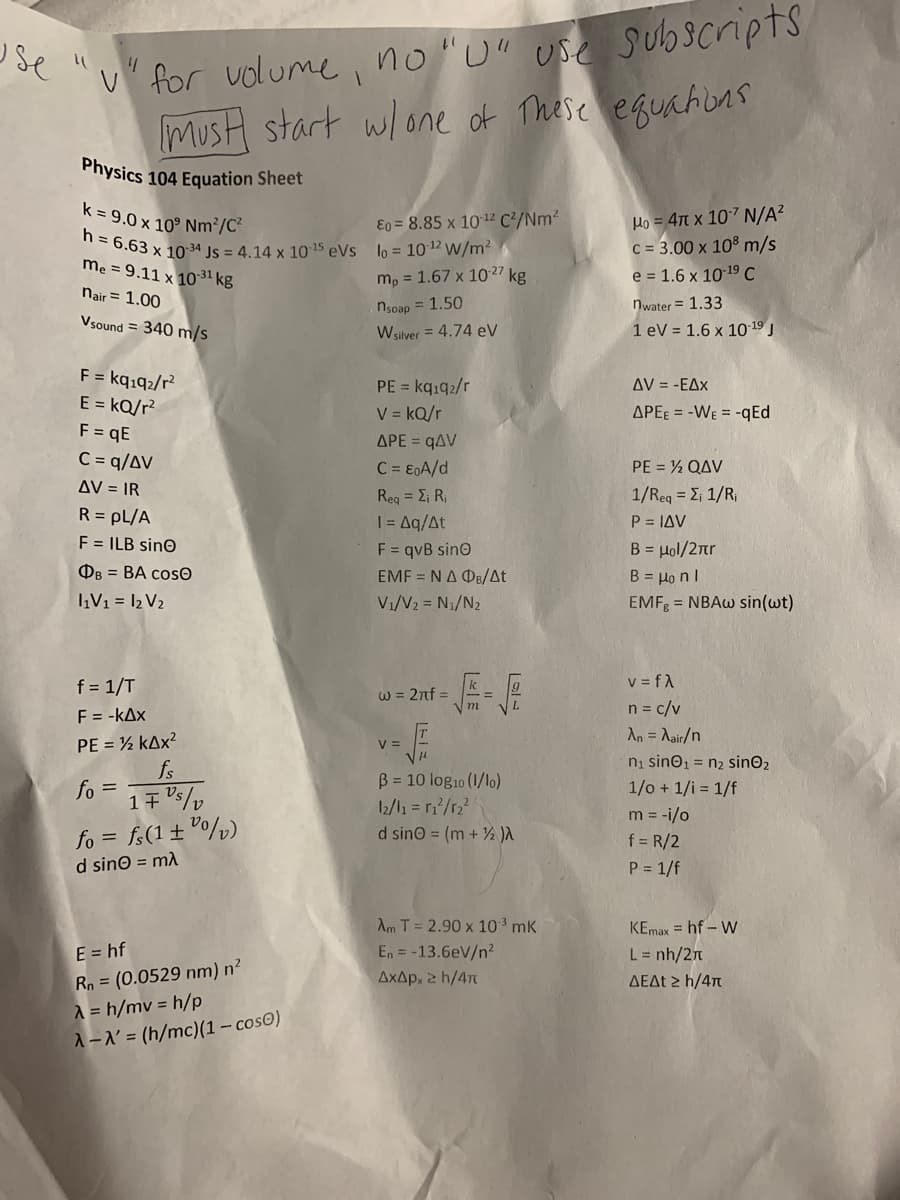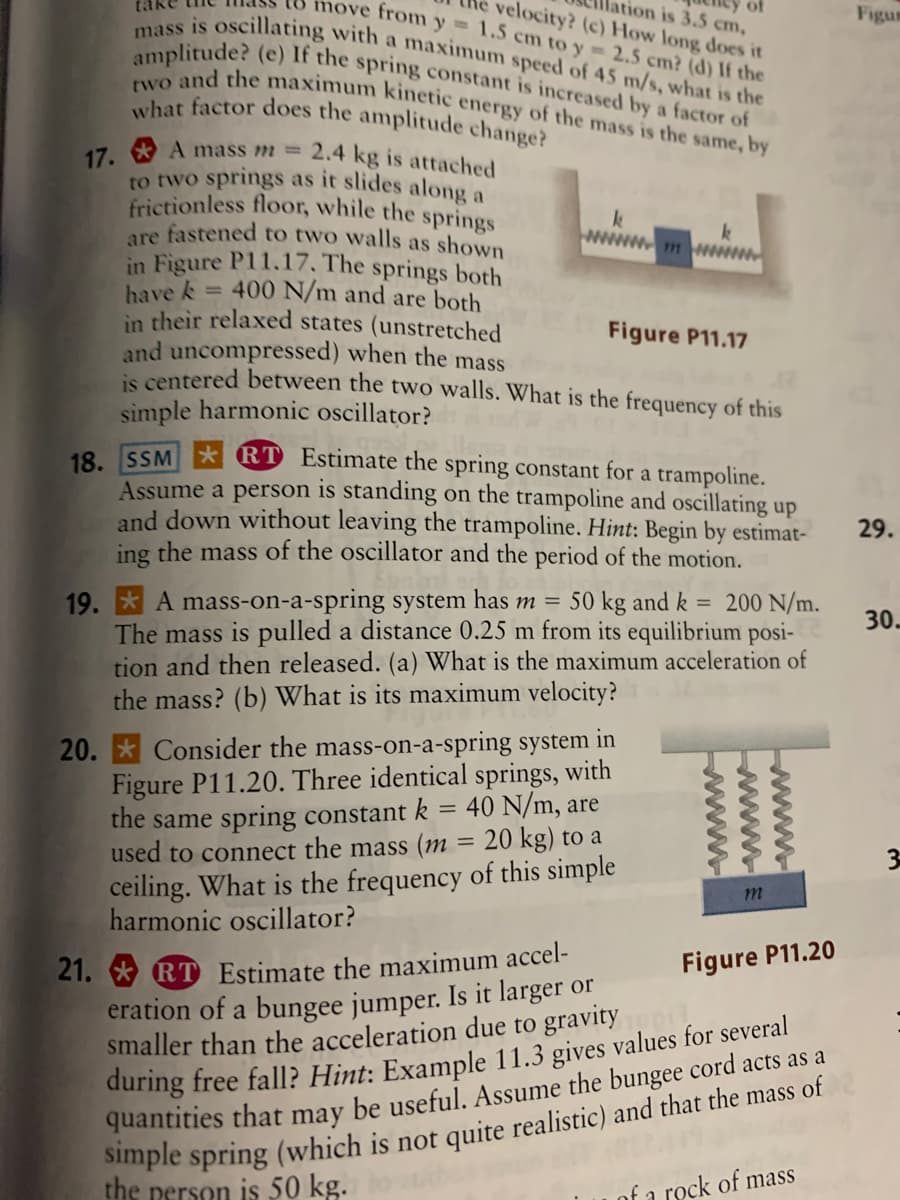19. A mass-on-a-spring system has m = 50 kg and k = 200 N/m. The mass is pulled a distance 0.25 m from its equilibrium posi- tion and then released. (a) What is the maximum acceleration of the mass? (b) What is its maximum velocity? %3D
19. A mass-on-a-spring system has m = 50 kg and k = 200 N/m. The mass is pulled a distance 0.25 m from its equilibrium posi- tion and then released. (a) What is the maximum acceleration of the mass? (b) What is its maximum velocity? %3D
University Physics Volume 1
18th Edition
ISBN:9781938168277
Author:William Moebs, Samuel J. Ling, Jeff Sanny
Publisher:William Moebs, Samuel J. Ling, Jeff Sanny
Chapter15: Oscillations
Section: Chapter Questions
Problem 69CP: Near the top of the Citigroup Center building in New York City, there is an object with mass of...
Related questions
Concept explainers
Question
Problem 19. Must use formula from formula sheet. Not sure which one or where to start.

Transcribed Image Text:v" for volume no"U" use subscripts
MusH start wlone of
use
These eguahbas
Physics 104 Equation Sheet
k = 9.0 x 10° Nm²/C²
Ho = 4M x 107 N/A?
C = 3.00 x 10° m/s
e = 1.6 x 10-19 c
Eo = 8.85 x 1012 C²/Nm?
"-6.63 x 10 34 Js = 4.14 x 10 15 eVs lo = 1012 W/m?
me = 9.11 x 10 kg
m, = 1.67 x 10 27 kg
nair = 1.00
nsoap = 1.50
nwater = 1.33
Vsound = 340 m/s
1 eV = 1.6 x 10 19 J
Wsilver = 4.74 eV
F = kqıq2/r²
E = kQ/r?
F = qE
PE = kqı92/r
V = kQ/r
ΔV - -ΕΔx
APEE = -WE = -qEd
APE = qAV
C = q/AV
C = E0A/d
R.Σ R
| = Aq/At
F = qvB sino
EMF = NA DB/At
PE = ½ QAV
AV = IR
1/Req Σ 1/R
P = IAV
B = Hol/2nr
R = PL/A
F = ILB sino
OB = BA cosO
B = Ho nl
¡V1 = 12 V2
V1/V2 = N1/N2
EMFg = NBAW sin(wt)
f = 1/T
v = fA
W = 2nf =
F = -kAx
n = c/v
An = Aair/n
PE = ½ KAX²
fs
fo =
V =
ni sino1 = n2 sino2
B = 10 log10 (1/lo)
12/l1 = r/r2?
d sino = (m + ½ )A
1/o + 1/i = 1/f
m = -i/o
fo = f.(1 ± °o/p)
d sino = m
f = R/2
P = 1/f
Am T = 2.90 x 103 mK
En = -13.6eV/n?
KEmax = hf – W
E = hf
L= nh/2n
Rn = (0.0529 nm) n²
A = h/mv = h/p
AxAp, 2 h/4n
ΔΕΔt h/4π
A-N' = (h/mc)(1 – cos©)

Transcribed Image Text:what factor does the amplitude change?
move from y= 1.5 cm to y= 2.5 cm? (d) If the
velocity? (c) How long does it
ation is 3.5 cm,
of
to two springs as it slides along a
amplitude? (e) If the spring constant is increased by a factor of
mass is oscillating with a maximum speed of 45 m/s, what is the
two and the maximum kinetic energy of the mass is the same, by
Figum
17. * A mass m =
2.4 kg is attached
frictionless floor, while the springs
are fastened to two walls as shown
in Figure P11.17. The springs both
a
k
mww
= 400 N/m and are both
have k
in their relaxed states (unstretched
and uncompressed) when the mass
is centered between the two walls. What is the frequency of this
Figure P11.17
simple harmonic oscillator?
19 SSM * RT Estimate the spring constant for a trampoline.
Assume a person is standing on the trampoline and oscillating up
and down without leaving the trampoline. Hint: Begin by estimat-
ing the mass of the oscillator and the period of the motion.
29.
19. * A mass-on-a-spring system has m =
The mass is pulled a distance 0.25 m from its equilibrium posi-
tion and then released. (a) What is the maximum acceleration of
the mass? (b) What is its maximum velocity?
50 kg and k
200 N/m.
%3D
30.
20. * Consider the mass-on-a-spring system in
Figure P11.20. Three identical springs, with
the same spring constant k
used to connect the mass (m = 20 kg) to a
ceiling. What is the frequency of this simple
harmonic oscillator?
40 N/m, are
%3D
%3D
m
21. * RT Estimate the maximum accel-
eration of a bungee jumper. Is it larger or
smaller than the acceleration due to gravity
during free fall? Hint: Example 11.3 gives values for several
Figure P11.20
Simple spring (which is not quite realistic) and that the mass of
the nerson is 50 kg.
of a rock of mass
Expert Solution
This question has been solved!
Explore an expertly crafted, step-by-step solution for a thorough understanding of key concepts.
Step by step
Solved in 2 steps with 1 images

Knowledge Booster
Learn more about
Need a deep-dive on the concept behind this application? Look no further. Learn more about this topic, physics and related others by exploring similar questions and additional content below.Recommended textbooks for you

University Physics Volume 1
Physics
ISBN:
9781938168277
Author:
William Moebs, Samuel J. Ling, Jeff Sanny
Publisher:
OpenStax - Rice University

Classical Dynamics of Particles and Systems
Physics
ISBN:
9780534408961
Author:
Stephen T. Thornton, Jerry B. Marion
Publisher:
Cengage Learning

Principles of Physics: A Calculus-Based Text
Physics
ISBN:
9781133104261
Author:
Raymond A. Serway, John W. Jewett
Publisher:
Cengage Learning

University Physics Volume 1
Physics
ISBN:
9781938168277
Author:
William Moebs, Samuel J. Ling, Jeff Sanny
Publisher:
OpenStax - Rice University

Classical Dynamics of Particles and Systems
Physics
ISBN:
9780534408961
Author:
Stephen T. Thornton, Jerry B. Marion
Publisher:
Cengage Learning

Principles of Physics: A Calculus-Based Text
Physics
ISBN:
9781133104261
Author:
Raymond A. Serway, John W. Jewett
Publisher:
Cengage Learning

Physics for Scientists and Engineers, Technology …
Physics
ISBN:
9781305116399
Author:
Raymond A. Serway, John W. Jewett
Publisher:
Cengage Learning

Physics for Scientists and Engineers with Modern …
Physics
ISBN:
9781337553292
Author:
Raymond A. Serway, John W. Jewett
Publisher:
Cengage Learning

Physics for Scientists and Engineers
Physics
ISBN:
9781337553278
Author:
Raymond A. Serway, John W. Jewett
Publisher:
Cengage Learning